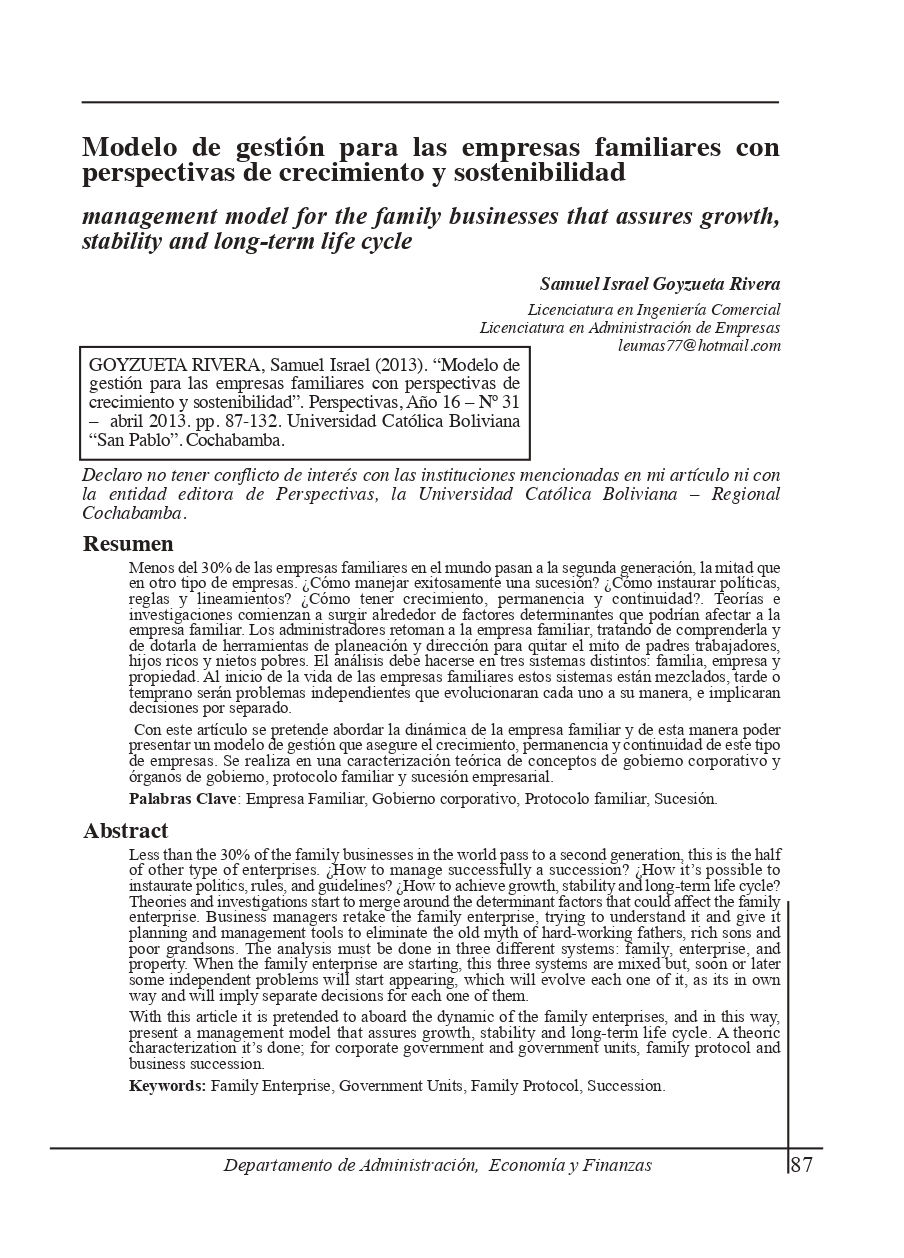management model for the family businesses that assures growth, stability and long-term life cycle
DOI:
https://doi.org/10.35319/n45q1868Keywords:
Family Enterprise, Government Units, Family Protocol, SuccessionAbstract
Less than the 30% of the family businesses in the world pass to a second generation, this is the half of other type of enterprises. ¿How to manage successfully a succession? ¿How it’s possible to instaurate politics, rules, and guidelines? ¿How to achieve growth, stability and long-term life cycle? Theories and investigations start to merge around the determinant factors that could affect the family enterprise. Business managers retake the family enterprise, trying to understand it and give it planning and management tools to eliminate the old myth of hard-working fathers, rich sons and poor grandsons. The analysis must be done in three different systems: family, enterprise, and property. When the family enterprise are starting, this three systems are mixed but, soon or later some independent problems will start appearing, which will evolve each one of it, as its in own way and will imply separate decisions for each one of them.
With this article it is pretended to aboard the dynamic of the family enterprises, and in this way, present a management model that assures growth, stability and long-term life cycle. A theoric characterization it’s done; for corporate government and government units, family protocol and business succession.
Downloads
References
ABITI, María Eugenia; OCEJO, Ximena (2004). “La sucesión de poder en la empresa familiar: análisis de dos casos”. Tesis Profesional para optar el grado de Licenciatura en Administración de Empresas – Universidad de las Américas. Puebla, México.
ADMINISTRACIÓN CAJÉN (2011). “Administración Cajén”
AMAT, Joan (2000). “La sucesión en la empresa familiar”. Ed. Deusto – 1ra. Ed. España.
AMAT, Joan (2004). “La continuidad de la empresa familiar”. Ed. Gestión – 1ra. Ed. España.
BELAUSTEGUIGOITIA, Imanol (2004). “Empresas familiares: su dinámica, equilibrio y consolidación”. Ed. McGraw-Hill – 1ra. Ed. México.
BELAUSTEGUIGOITIA, Imanol (2008). “La empresa familiar: Problemas y soluciones”
BELAUSTEGUIGOITIA, Imanol (2008). “Algunas ideas para prevenir conflictos en empresas familiares”
BELAUSTEGUIGOITIA, Imanol (2008). “La singular dinámica de la empresa familiar en Latinoamérica”
BRAIDOT, Néstor; SOTO, Eduardo (1997). “Las Pymes latinoamericanas”. Ed. IFEMA – 2da. Ed. México.
CONFECÁMARAS (2008). “Guía colombiana para gobierno corporativo para sociedades cerradas y de familia”. Ed. Confecámaras – Colombia.
CONFECÁMARAS (2008). “Código marco de buen gobierno corporativo para pequeñas y medianas empresas”. Ed. Confecámaras – Colombia.
CUPRUM-AFP (2008). “Buen gobierno corporativo es buen negocio para todos”. Ed. Cuprum-AFP – 1ra. Ed. Chile.
DG DE POLÍTICA DE LA PYME (2008). “Guía para la pequeña y mediana empresa familiar”. Publicación. Ed. Dirección General de Política de la Pequeña y Mediana Empresa – 1ra. Ed. España.
DODERO, Santiago (2002). “El secreto de las empresas familiares exitosas”. Ed. El Ateneo – 1ra. Ed. Argentina.
DODERO, Santiago (2005). “El ciclo de vida de las empresas familiares”
DODERO, Santiago (2005). “Investigación sobre la empresa familiar en Latinoamérica”
DODERO, Santiago; PITHOD, Abelardo (2001). “El desarrollo del espíritu emprendedor en las empresas familiares”
GEEF (2011). “Groupement Européen des Entreprises Familiales”
GINEBRA, Joan (1997). “Las empresas familiares: su dirección y su continuidad”. Ed. Panorama – 1ra. Ed. México.
KAMEI, Katsuyuki (2008). “Tradition and Innovation in Japanese Family SME”
MIF-FOMIN (2008). “Guía de Aprendizaje sobre la implementación de RSE en la Pyme”. Ed. FOMIN – 1ra. Ed. Perú.
MINISTERIO DE DESARROLLO ECONÓMICO (2003). “Formalización de Micro y Pequeños Productores”. Publicación financiada por el proyecto BCCN de USAID – Bolivia.
MURDOCK, George (1969). “Culture and Society”. Ed. University of Pittsburgh Press – 2da. Ed. Estados Unidos.
NEUBAUER, Franz; LANK, Alden (1998). “The family business: its governance for sustainability”. Ed. Routledge – 2da. Ed. Estados Unidos.
PALACIOS, Jesús; RODRIGO, María José (1998). “Familia y Desarrollo Humano”. Ed. Alianza – 1ra. Ed. España.
QUISBERT, Ermo (2010). “La sucesión”
UREY HIGAZY, Roger Javier (2008). “Padres trabajadores, hijos ricos, nietos pobres ¿mito o realidad?”. Ed. La Hoguera – 1ra Ed. Bolivia.
VELEZ, Diego; HOLGUÍN, Harry; DE LAHOZ, Gerardo; DURÁN, Yasmín; GUTIÉRREZ, Irma (2008). “Dinámica de la empresa familiar Pyme. Estudio exploratorio en Colombia”. Ed. FUNDES – 1ra. Ed. Colombia.
VISSER, Wayne; MATTEN, Dirk; POHL, Manfred (2010). “The A to Z of Social Corporate Responsibility”. Ed. ICCE – 2da. Ed. Reino Unido.
ZEBALLOS, Emilio; VELAZCO, Enrique (2003). “Construyendo el desarrollo a través de las Pymes”. Ed. FUNDES – 1ra. Ed. Bolivia.

Downloads
Published
Issue
Section
License
Copyright (c) 2013 Revista Perspectivas

This work is licensed under a Creative Commons Attribution-NonCommercial-ShareAlike 4.0 International License.
La Revista Perspectivas de la Universidad Católica Boliviana, es una revista de acceso abierto, por lo tanto, es de libre acceso en su integridad. Está permitida su lectura, búsqueda, descarga, distribución y reutilización legal en cualquier tipo de soporte únicamente para fines no comerciales, siempre y cuando la obra sea debidamente citada.




